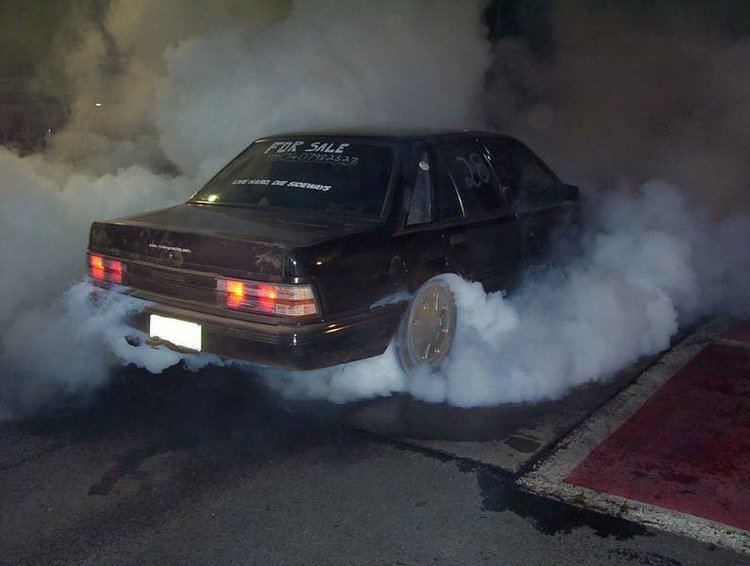 | ||
Hoon is a term primarily used in Australia and New Zealand to describe the act of driving a vehicle at high speed and pulling manoeuvres likely to cause excitement and cheers from onlookers.
Contents
Hoon activities can include speeding, burnouts, doughnuts or screeching tyres. Those commonly identified as being involved in "hooning" or street racing are young and predominantly male, although increasingly female, drivers in the age range of 17 and 35 years.
Hoon control laws are beginning to be extended to dangerous hoon behaviour using boats and other vessels, particularly jet skis. The State of Victoria, Australia passed legislation in late 2009 to control hoon activities using recreational vessels.
Etymology
At the turn of the 20th century in Australia, the term "hoon" (and its rhyming slang version "silver spoon", and also "banana") had a different meaning: one who lived off immoral earnings (i.e. the proceeds of prostitution, a pimp or procurer of prostitutes).
Linguist Sid Baker in his book The Australian Language suggested that "hoon" (meaning "a fool") was a contraction of Houyhnhnm, a fictional race of intelligent horses which appears in Gulliver's Travels by Jonathan Swift.
Hoon, when used in relation to people in motor vehicles (or associated with car culture), may be onomatopoeia. One may speak of a car, or its driver, or its occupants in general as "hooning down the road".
It could also be a clipped form of "hooligan" or a portmanteau of "hooligan" and "goon" or "buffoon".
Anti-hoon legislation in Australia
The term "hoon" has obtained a semi-official use in Australia, with police and Governments referring to legislation targeting anti-social driving activity as "anti-hoon laws". The term has even begun to appear in the titles of legislation, for example the Transport Legislation Amendment (Hoon Boating and Other Amendments) Act 2009 of the State of Victoria.
In Western Australia, the Road Traffic Amendment (Impounding and Confiscation of Vehicles) Bill 2004, which was passed by the Parliament of Western Australia in June 2004, empowered the Western Australia Police to confiscate and impound vehicles found to be engaging in excessive speed or noise. The law was used to impound a Lamborghini that was being driven by a mechanic without the owner's knowledge. The police claim that the law does not permit them to release the car under the only legal course of action available to the owner, that of "hardship". The police retorted that, having the means to own it, "he can afford to hire a vehicle." The owner complained that the law amounted to "mandatory sentencing without trial". The Western Australian Police Minister, Rob Johnston, "admits the laws are unfair but says he stands by them". Former Western Australia District Court Chief Judge Antoinette Kennedy described the minister's reaction as "the politics of envy". After all 'hoon'-related offences, the defendant's licence is cancelled and experience accumulated on it is returned to zero.
In the state of Victoria, hoon-related offences include burnouts, doughnuts, drag racing, repeated driving while disqualified and high-level speeding were added to Section 84C of the Road Safety Act 1986 in July 2006. Victoria Police have impounded an average of ten cars a day under the laws, with over 5,000 vehicles confiscated and impounded two years after their introduction. By contrast, the hoon boating laws of Victoria currently centre on offences involving dangerous behaviour and do not yet reference offences relating to public order or amenity.
In Queensland, the Police Powers and Responsibilities Act 2000 allows members of the Queensland Police to impound the vehicles involved in prescribed offences. The laws relating to confiscation of vehicles for offences such as street racing, time trials and burnouts were strengthened in 2002. Further laws introduced in July 2008 provided for the confiscation of vehicles for repeat offenders involved with drunk driving, driving while suspended or driving with illegal modifications.
The maximum penalty for hooning in Queensland is $4,712 or 6 months imprisonment. Repeat offenders can lose their vehicle for 48 hours for the first repeat offence, up to three months for a second repeat offence, or permanently for a third repeat offence. On 11 August 2008, a number of confiscated vehicles were auctioned by the government; the remainder were crushed and sold as scrap metal.
In New South Wales, the word "hoon" is actually contained in the name of the legislation - the Road Transport Legislation Amendment (Car Hoons) Act 2008 enacted in July 2008 - which introduced new measures against street racing and increased fines. Previous legislation provided only for the vehicles of repeat offenders to be forfeited to the Crown, but the Car Hoons Act allowed for them to be used in crash testing by the Roads and Traffic Authority, for educational and deterrence purposes, and roadworthiness testing in the context of modifications.
In South Australia, the relevant legislation is the Criminal Law (Clamping, Impounding And Forfeiture Of Vehicles) Act 2007. The legislation, amended in December 2009, directs that, upon conviction for a 'prescribed offence' the motor vehicle be forfeited to the Crown; the Police Commissioner then has discretion to sell or otherwise dispose of it, i.e. crush it. At the end of 2010, 62 cars had been impounded by the courts. None were worth more than $1600 and many were not capable of reaching 150 km/h.
The laws are still being updated in Tasmania.
